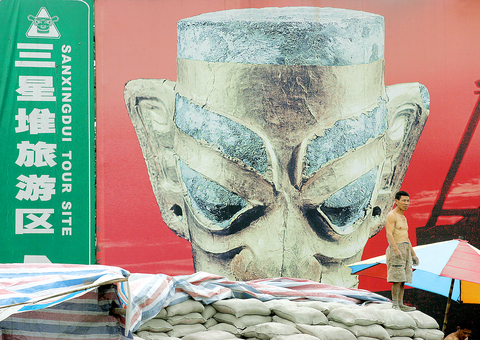Day after sweltering day on the banks of the Modi stream, archeologists are dealing shattering blows to traditional views of Chinese history as they work their way through the parched, yellow earth.
One of the world's great cities once flourished here at Jinsha village in China's southwest, the 1000BC equivalent of New York or Paris, and then inexplicably vanished, leaving no trace behind in the historical records.
Until recently, locals had no idea they were living on top of a great lost bronze-age civilization.

PHOTO: AFP
"Of course, people get excited when they hear that their home area has such a long history, such an advanced culture, and such refined art," said Jiang Zhanghua, deputy head of the Institute of Archeology in nearby Chengdu City.
The discovery of the site was entirely fortuitous, reflecting how much of the patchy record of the pre-historic past has come together merely by chance.
On a winter day in early 2001, excavation teams sent to the site by a property developer unearthed large numbers of ivory and jade artifacts that clearly suggested a major find.
If the company had decided to just carry on its work, covering the site in concrete as is believed by archeologists to be quite common, the Jinsha civilization might have been forgotten forever. But they called in authorities.
Weird masks
In and by themselves, the artifacts are striking in their weirdness -- masks with strangely protruding eyes, cult statues frozen in poses of unknown, but likely religious, significance.
More importantly, the spectacular discovery in Jinsha has added to the mass of evidence forcing historians to rethink Chinese history as a whole.
It is now clear that Chinese culture had multiple origins and did not, as previous generations of historians confidently believed, follow a simple path from just one single source.
It is a popular idea that the cradle of Chinese civilization is in the Yellow River valley about 1,000km northeast of Chengdu, and matured there before gradually spreading southward.
If nothing else, this traditional concept of history is supported by ancient myths about the Yellow Emperor and other early rulers, held dear by many Chinese.
But historians have long suspected this cannot be right. Ever since, that is, the discovery of the Sanxingdui civilization, about 50km from the Jinsha excavation site.
Here archeologists have been unearthing artifacts for most of the 20th century, discovering what now is confirmed as one of the world's major pre-historic civilizations.
The Sanxingdui culture, which blossomed from 5000BC to 3000BC, is characterized by the same radical strangeness as that unearthed at Jinsha.
Masks with oversized eyes and eyebrows, with some of them covered with gold leaf, are among its hallmarks.
But even as they display unique features, both Sanxingdui and Jinsha also show remarkable parallels with other ancient cultures.
Sacred sun and trees
"Sun worship was practiced here at the same time as it formed a central part of ancient Egyptian cults," says Zhu Yarong, a young historian at the large museum erected at Sanxingdui.
"People here appear to have worshipped sacred trees, just like in Mesopotamia, in modern-day Iraq," she says.
As the archeologists analyze the finds, they try to solve important questions, such as why the Sanxingdui site had a city wall while Jinsha did not.
The absence of a city wall in Jinsha is particularly strange, because cities in ancient China emerged as concentrations of political power, not trading centers as was mostly the case in the west.
Researchers also know little about the ties the Sanxingdui and Jinsha people had with other cultures, even if they can determine that exchanges must have been frequent.
The archeological teams have uncovered large numbers of ivory tusks originating from China's current border with mainland Southeast Asia.
The question is, how did they get here, and why?
Other questions remain. Where did the Sanxingdui and Jinsha people come from? Where did they go? And what exactly characterized their religion?
These are questions that may never be answered, because the Sanxingdui people left no written record. It is odd that people at their stage of development did not invent some type of writing system, but it is not unheard of.
Other civilizations, most notably in pre-Columbian America, were also illiterate, even as they were highly advanced in other fields such as architecture and astronomy.
Hidden knowledge
For Zhu, the museum historian, the discovery of written records would be a dream come true, unlocking hidden knowledge about how the mystical ancient inhabitants of the area lived and what their thoughts and feelings were.
"We don't know if they actually did invent writing. Maybe they did, but they used a material that has not survived to this day. It would be major, major step forward if we found written records," she says.

PARLIAMENT CHAOS: Police forcibly removed Brazilian Deputy Glauber Braga after he called the legislation part of a ‘coup offensive’ and occupied the speaker’s chair Brazil’s lower house of Congress early yesterday approved a bill that could slash former Brazilian president Jair Bolsonaro’s prison sentence for plotting a coup, after efforts by a lawmaker to disrupt the proceedings sparked chaos in parliament. Bolsonaro has been serving a 27-year term since last month after his conviction for a scheme to stop Brazilian President Luiz Inacio Lula da Silva from taking office after the 2022 election. Lawmakers had been discussing a bill that would significantly reduce sentences for several crimes, including attempting a coup d’etat — opening up the prospect that Bolsonaro, 70, could have his sentence cut to

China yesterday held a low-key memorial ceremony for the 1937 Nanjing Massacre, with Chinese President Xi Jinping (習近平) not attending, despite a diplomatic crisis between Beijing and Tokyo over Taiwan. Beijing has raged at Tokyo since Japanese Prime Minister Sanae Takaichi last month said that a hypothetical Chinese attack on Taiwan could trigger a military response from Japan. China and Japan have long sparred over their painful history. China consistently reminds its people of the 1937 Nanjing Massacre, in which it says Japanese troops killed 300,000 people in what was then its capital. A post-World War II Allied tribunal put the death toll

‘UNWAVERING ALLIANCE’: The US Department of State said that China’s actions during military drills with Russia were not conducive to regional peace and stability The US on Tuesday criticized China over alleged radar deployments against Japanese military aircraft during a training exercise last week, while Tokyo and Seoul yesterday scrambled jets after Chinese and Russian military aircraft conducted joint patrols near the two countries. The incidents came after Japanese Prime Minister Sanae Takaichi triggered a dispute with Beijing last month with her remarks on how Tokyo might react to a hypothetical Chinese attack on Taiwan. “China’s actions are not conducive to regional peace and stability,” a US Department of State spokesperson said late on Tuesday, referring to the radar incident. “The US-Japan alliance is stronger and more

FALLEN: The nine soldiers who were killed while carrying out combat and engineering tasks in Russia were given the title of Hero of the Democratic People’s Republic of Korea North Korean leader Kim Jong-un attended a welcoming ceremony for an army engineering unit that had returned home after carrying out duties in Russia, North Korean state media KCNA reported on Saturday. In a speech carried by KCNA, Kim praised officers and soldiers of the 528th Regiment of Engineers of the Korean People’s Army (KPA) for “heroic” conduct and “mass heroism” in fulfilling orders issued by the ruling Workers’ Party of Korea during a 120-day overseas deployment. Video footage released by North Korea showed uniformed soldiers disembarking from an aircraft, Kim hugging a soldier seated in a wheelchair, and soldiers and officials